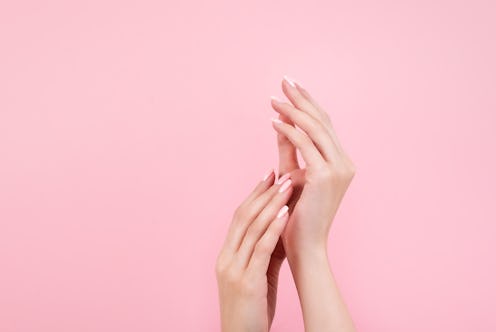Beauty
Do Your Nails Really Need To Breathe? Experts Explain
Listen up.

Taking breaks from wearing polish to let your nails "breathe" is a long-standing beauty belief, similar to the idea that makeup breaks allow your skin to get some air. Supposedly, going au naturel is beneficial. But... do nails need to breathe?
Experts say it's a complete myth. "Once you can see your nail plate and it comes out from beneath the cuticle, it's dead," says cosmetic biochemist and StimuNail founder Stacey Steinmetz. "Only when it's being grown underneath your cuticle, in an area called the nail matrix, is it alive." She compares it to shingles on a roof: The cells of your nail build upon each other as they grow, she explains, and they push forward older cells to form the visible nail plate.
Rather than get air and nutrients from, well, being naked — sans polish — your nails are fed from below. "Nails derive oxygen and nutrients from the blood supply and not the air," says Dr. Dana Stern, M.D., a board-certified dermatologist who specializes in nail health. Steinmetz adds that "nothing is coming from the environment" to nourish your nails.
What Does Nail Polish Do To Your Nails?
How does polish affect your nail health, then? According to Steinmetz, it works to seal in moisture. "The most important thing to keeping your nails strong and preventing them from breaking is keeping the moisture level up," she tells Bustle. "Having polish on your nail, even if it's just a clear coat, prevents the water from being evaporated through your nail plate." She notes that activities like showering or doing the dishes can be dehydrating, since your nail plate absorbs that water and removes the oils that are naturally "keeping your nails supple." Stern refers to polish as a "barrier layer" for your nails, since it protects them from this moisture evaporation.
This means that wearing polish isn't a bad thing, and it's not necessarily wrecking your nails. "Polish also serves to keep the cells that make up the nail stick together more effectively so they are less likely to fray, peel, and split," adds Stern.
How Do Your Nails Get Damaged, Then?
The culprit isn't your polish: "Most of the damage from basic polish is the removal process," says Stern. "Polish remover significantly dries out the nail and leads to brittleness, splitting, peeling, and breakage." That's because they're formulated with solvents, like acetone or ethyl acetate, which suck moisture out of your nail.
Should You Ever Take A Break From Nail Polish?
This all isn't to say that nail polish is a complete must for your beauty routine. According to Stern, if you notice rough, white patches, on your nails, peeling, ridges, splits, discoloration, or dehydrated cuticles, it's time to take a polish break. "These are all signs that your nail health is compromised from too much polish," she says.
You should also make sure you're not leaving your polish on for too long. "You could dehydrate nails and cause them to peel and become brittle," says Steinmetz. She recommends removing polish about 2 to 3 weeks after application. "If you see any signs of damage [mentioned above], take a break for a few months," she tells Bustle. And, for your best nail health, treat your tips to a cuticle oil twice a day to help hydrate and prevent further damage, says Steinmetz.
Other than that? Go forth with that mani.
Studies referenced:
Baswan, S. (2017). Understanding the Formidable Nail Barrier: A Review of the Nail Microstructure, Composition and Diseases. Mycoses. https://www.ncbi.nlm.nih.gov/pmc/articles/PMC5383514/
Batory, M. (2019). The effect of various primers improving adhesiveness of gel polish hybrids on pH, TOWL and overall nail plates condition. Journal of Cosmetic Dermatology. https://www.researchgate.net/publication/330282572_The_effect_of_various_primers_improving_adhesiveness_of_gel_polish_hybrids_on_pH_TOWL_and_overall_nail_plates_condition
Cashman, M.W. (2010. Nutrition and Nail Disease. Clinics in Dermatology. https://www.sciencedirect.com/science/article/abs/pii/S0738081X10000611?via%3Dihub
Farran, L. (2008). The effect of humidity on the fracture properties of human fingernails. Journal of Experimental Biology. https://jeb.biologists.org/content/211/23/3677
Reinecke, J. (2020). Nail health in women. International Journal of Women's Dermatology. https://www.ncbi.nlm.nih.gov/pmc/articles/PMC7105659/
Experts:
Stacey Steinmetz, cosmetic biochemist and StimuNail founder
Dr. Dana Stern, M.D., board-certified dermatologist who specializes in nail health
This article was originally published on